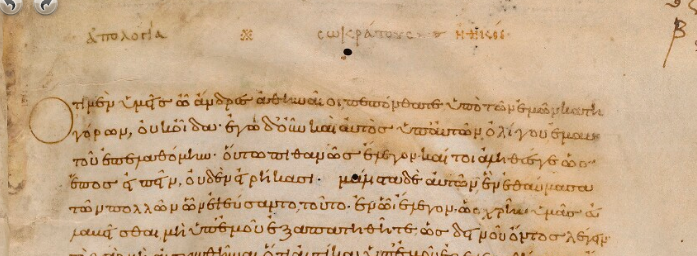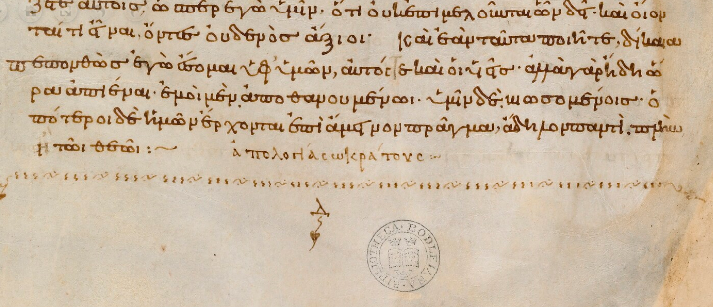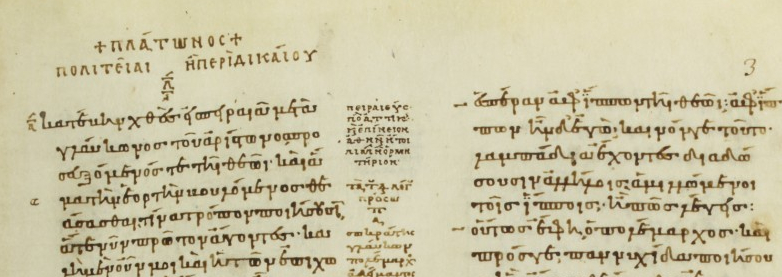PHI 328: History of Ancient Philosophy
A History from the Presocratic Period through the Period of Schools
Plato's
Apology,
first (8r) and last page (20r).
Bodleian Library MS. E. D. Clarke 39, B (895 CE)
This manuscript contains the first six tetralogies.
fol. 8r

The title Ἀπολογία ("Apology") is in the upper left. In the upper right is Σωκράτους ἠθικός ("ethics of Socrates").
fol. 20r

The terms recto and verso are shortened from the Latin recto folio and
verso folio, which mean "on the right side"
and "on the back side of a leaf" in a codex.
fol. 8r, for example, shown above, designates the right side of leaf 8.
Plato's Republic, first page (3r).
Codex Parisinus graecus 1807, A (c. 900 CE).
This manuscript contains the last two tetralogies
fol. 3r

Πλάτωνος (genitive form of the nominative Πλάτων or "Plato")
is at the top. It
is followed by the title Πολιτεία ("the conditions and rights of the citizen") and subtitle
ἢ περὶ δικαίου ("or about justice").
The earliest Greek inscriptions were written from right to left in what is called retrograde.
The Phoenicians wrote this way, and the Greeks derived their alphabet from them sometime early in the 8th century BCE.
Nestor's Cup (750-700 BCE),
SEG 14: 604
This shows the
earliest known example of the new Phoenician-influenced
Greek alphabet.



The first word (Νέστορος, genitive of
Νέστωρ)
is relatively clear. The translation of the text itself is disputed.
Here is one possibility:
"I am Nestor’s cup, good to drink from.
Whoever drinks this cup empty, immediately
the desire for fair-garlanded Aphrodite will seize."
The double dots facilitate reading
(which was difficult for scriptio continua). The first line,
which seems to be written in a version of iambic trimeter, has a double dot between each word.
In the next two lines, written in dactylic hexameter, the same sign seems to mark caesura.
caesura. In
"To be, or not to be--that is the question," there are two. They occur after the first
and second 'be.'
After about 600 BCE, there are examples of inscriptions in the
βουστροφηδόν
("turning like an ox in plowing") style. In this style, alternate lines
are reversed with reversed letters.
"In some cases the letters read straight on, but in others the form of the writing is
what the Greeks call βουστροφηδὸν. It is like this: at the end of the line the second
line turns back, as runners do when running the double race"
(Pausanias,
Description of Greece 5.17.16).
The Phanodikos stela
(575-550 BCE), IG I³ 1508,
shows an example of βουστροφηδὸν.
Here is an image of the
first two lines:

After 500 BCE, writing left to right is the norm.
The history of Ancient philosophy is a history of what the Ancient philosophers thought.
Texts are the Evidence
The primary evidence for what these philosophers thought is the writings these philosophers authored and the writings about them from other authors in the period.
We can think about Plato to see where we stand with respect to these writings.
The oldest manuscript we possess for Plato is MS. E.D. Clarke 39. It dates to 895 CE. On the basis of this and other manuscripts, scholars have reached decision about the words in the works that Plato authored over a thousand years earlier in the 4th century BCE.
The reconstructed texts that have resulted from these decisions are now mostly online.
This gives us a place to start. On the basis of the enormous amount of work that has already been done, we try to understand what the philosophers were saying in these texts.
An Outline of this Course
1. Introduction
Ancient Greek Philosophy, Introduction (1-8)
• The period of study
• The language in the period
• Methodology in the History of Philosophy
2. The Presocratic Period
Ancient Greek Philosophy, Chapter 1 (9-34)
• The social and political conditions in the Mediterranean
• Enlightenment thinking, the Milesian Revolution, the beginnings of philosophy
• Parmenides, reason and experience
• Democritus and Leucippus, how to understand the inquiry into nature
• Quiz,
Prompts, Debriefing
3. Socrates, the Historical Figure and the Character
Ancient Greek Philosophy, Chapters 2 and 3 (35-69, 70-95)
• The Age of Pericles, the trial and execution of Socrates
• Socrates and “love of wisdom” (φιλοσοφία)
• The new teachers, the Sophists
• Two lives, the life in the love of wisdom, the life the new teachers sell
• Quiz,
Prompts, Debriefing
4. Plato and the Academy
Ancient Greek Philosophy, Chapters 4 and 5 (98-130, 131-149)
• The Peloponnesian War and the end of the Golden Age
• The Theory of Recollection, the Theory of Forms, the Tripartite Theory of the Soul
• The just life is better than the unjust life
• A renewed interest in nature, the teleological perspective
• Quiz,
Prompts, Debriefing
5. Aristotle and the Lyceum
Ancient Greek Philosophy, Chapters 6 - 9 (151-171, 172-187, 188-204, 205-223)
• The rise of Macedon, Alexander the Great
• The first great Platonist and Plato's first great critic
• Physics is second philosophy, becoming like the unmovable first mover
• The soul is the form of the body, the best life for a human being
• Quiz,
Prompts, Debriefing
6. The Hellenistic Philosophers
Ancient Greek Philosophy, Chapter 10 (225-256)
• Classical antiquity from Alexander to Cleopatra
• Epicurus and the Epicureans
• The Stoics
• The Academics
• Quiz,
Prompts, Debriefing
A Strategy for getting a High Grade
Focus on the lecture notes. They set out the most important points to know for the purpose of the course. As you read the notes, look for answers to the questions posed in the writing assignments. Once you understand these answers, read more widely as time allows.
The textbook can be useful, but I think the lecture notes are now much better.
In the five debriefing sessions (10% of the total grade), you only need to say something coherent about your experience of reading and thinking about the material in the unit.
The five quizzes (50% of the total grade) test your knowledge of basic facts. Basic facts are facts like these: Ancient philosophy began in 585 BCE, Plato is a philosopher in the Period of Schools, and so on. The quizzes consist in multiple choice questions, so you only need to recognize the best answer. The quizzes are not timed. You have two attempts.
The ten prompts (40% of the total grade) are the hardest part of the course. You have to explain what some Ancient philosopher thought. This is not easy, but the grade is pass/fail.

